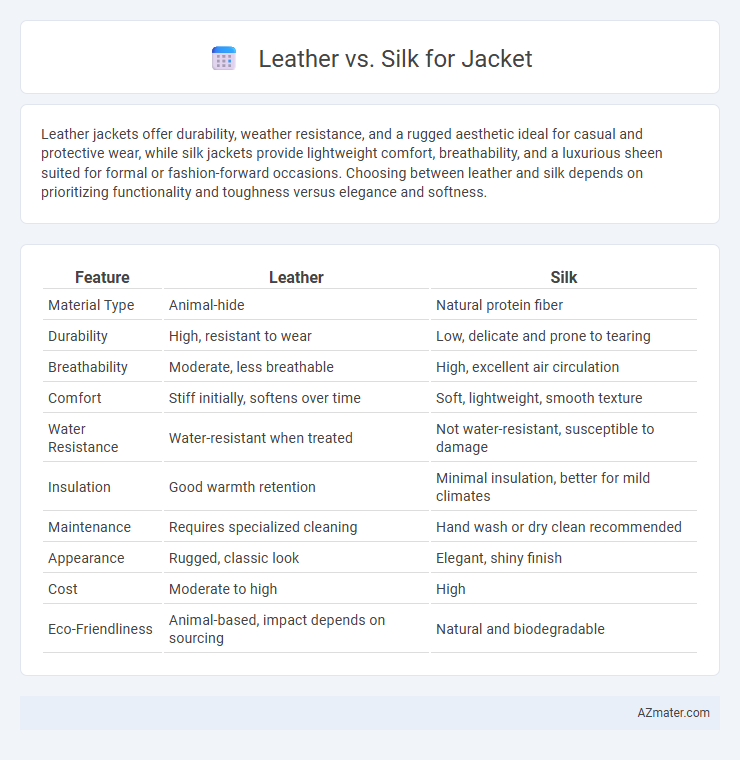Leather jackets offer durability, weather resistance, and a rugged aesthetic ideal for casual and protective wear, while silk jackets provide lightweight comfort, breathability, and a luxurious sheen suited for formal or fashion-forward occasions. Choosing between leather and silk depends on prioritizing functionality and toughness versus elegance and softness.
Table of Comparison
| Feature | Leather | Silk |
|---|---|---|
| Material Type | Animal-hide | Natural protein fiber |
| Durability | High, resistant to wear | Low, delicate and prone to tearing |
| Breathability | Moderate, less breathable | High, excellent air circulation |
| Comfort | Stiff initially, softens over time | Soft, lightweight, smooth texture |
| Water Resistance | Water-resistant when treated | Not water-resistant, susceptible to damage |
| Insulation | Good warmth retention | Minimal insulation, better for mild climates |
| Maintenance | Requires specialized cleaning | Hand wash or dry clean recommended |
| Appearance | Rugged, classic look | Elegant, shiny finish |
| Cost | Moderate to high | High |
| Eco-Friendliness | Animal-based, impact depends on sourcing | Natural and biodegradable |
Introduction to Leather and Silk Jackets
Leather jackets, crafted from durable and natural animal hides, offer excellent insulation and a timeless, rugged aesthetic favored in fashion and functional outerwear. Silk jackets, made from fine, lightweight fibers produced by silkworms, provide a luxurious texture and elegant sheen, ideal for formal or stylish weather layering. Both materials serve distinct purposes with leather excelling in durability and protection, while silk emphasizes comfort and sophistication.
Material Origins: Leather vs Silk
Leather jackets originate from the durable hides of animals such as cows, providing a rugged texture and natural insulation, while silk jackets are crafted from the fine protein fibers produced by silkworm cocoons, offering a smooth, lightweight, and breathable fabric. The tanning process transforms raw animal hides into flexible, long-lasting leather, whereas silk undergoes reeling and weaving to create its lustrous, soft material. These distinct material origins influence jacket durability, breathability, and overall sensory experience, making leather ideal for weather resistance and silk preferred for elegance and comfort.
Aesthetic Appeal and Style Comparisons
Leather jackets exude a rugged, timeless aesthetic with a bold, edgy vibe that complements casual and streetwear styles, often featuring rich textures and deep, natural tones. Silk jackets showcase a sleek, luxurious appearance with a smooth, glossy finish that adds elegance and sophistication, ideal for formal and high-fashion ensembles. While leather emphasizes durability and a classic biker look, silk prioritizes lightness and refined sheen, catering to distinct style preferences and occasions.
Comfort and Wearability
Leather jackets offer durability and a structured fit but can feel stiff and less breathable, making them less comfortable in warmer climates. Silk jackets excel in softness and breathability, providing a lightweight and luxurious feel ideal for mild weather. Choosing between leather and silk jackets depends on desired comfort level, climate conditions, and intended use, balancing wearability with material characteristics.
Durability and Longevity
Leather jackets offer superior durability due to their thick, natural fibers that resist abrasions, tears, and weather damage, making them ideal for long-term use. Silk jackets, while luxurious and lightweight, lack the structural strength and are more prone to wear, fading, and damage from exposure to moisture and friction. Choosing leather ensures enhanced longevity and protection, whereas silk requires delicate handling and limited wear to maintain its appearance over time.
Weather Resistance and Seasonal Suitability
Leather jackets offer superior weather resistance due to their natural durability and water-repellent properties, making them ideal for cooler, windy, or rainy conditions. Silk jackets, while breathable and lightweight, lack significant weather resistance and are better suited for mild, dry weather or transitional seasons like spring and early fall. Choosing between leather and silk depends on balancing protection from the elements with comfort based on seasonal changes.
Maintenance and Care Requirements
Leather jackets demand regular conditioning with specialized leather balms to prevent drying and cracking, while avoiding prolonged exposure to water and direct sunlight. Silk jackets require delicate handling, including hand washing with mild detergents or professional dry cleaning to maintain fabric integrity and luster. Both materials benefit from proper storage in breathable garment bags to preserve texture and extend garment lifespan.
Environmental Impact and Sustainability
Leather jackets have a significant environmental footprint due to the resource-intensive livestock farming and chemical tanning processes, contributing to deforestation, greenhouse gas emissions, and water pollution. Silk production, while renewable and biodegradable, often involves intensive water use and sometimes harmful chemicals in sericulture and processing stages. Sustainable alternatives like lab-grown leather and organic silk aim to reduce these impacts by minimizing resource use and chemical treatments in jacket manufacturing.
Price and Value Considerations
Leather jackets generally come with a higher price tag due to the durability and premium nature of genuine animal hide, offering long-lasting value through resistance to wear and weather. Silk jackets tend to be less expensive upfront but may require more delicate care and offer less durability, making them a more seasonal or fashion-focused investment. Evaluating price versus value involves considering leather's robust longevity against silk's lightweight elegance and lower initial cost.
Choosing the Right Jacket: Leather or Silk
Leather jackets offer durability and insulation, making them ideal for cold weather and rugged use, while silk jackets provide lightweight comfort and a luxurious sheen perfect for formal or mild climates. Choosing the right jacket depends on your lifestyle needs, whether you prioritize warmth, breathability, or style versatility. Leather excels in protection and longevity, whereas silk stands out for elegance and softness, influencing your decision based on occasion and weather conditions.

Infographic: Leather vs Silk for Jacket
 azmater.com
azmater.com